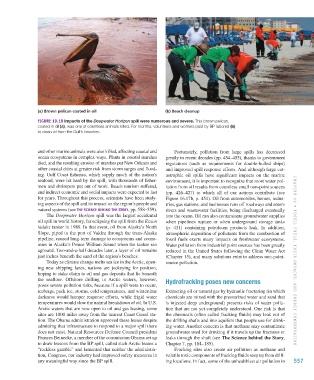Page 558 - Environment: The Science Behind the Stories
P. 558
(a) Brown pelican coated in oil (b) Beach cleanup
FIGURE 19.18 Impacts of the Deepwater Horizon spill were numerous and severe. This brown pelican,
coated in oil (a), was one of countless animals killed. For months, volunteers and workers paid by BP labored (b)
to clean oil from the Gulf’s beaches.
and other marine animals were also killed, affecting coastal and Fortunately, pollution from large spills has decreased
ocean ecosystems in complex ways. Plants in coastal marshes greatly in recent decades (pp. 454–455), thanks to government
died, and the resulting erosion of marshes put New Orleans and regulations (such as requirements for double-hulled ships)
other coastal cities at greater risk from storm surges and flood- and improved spill response efforts. And although large cat-
ing. Gulf Coast fisheries, which supply much of the nation’s astrophic oil spills have significant impacts on the marine
seafood, were hit hard by the spill, with thousands of fisher- environment, it is important to recognize that most water pol-
men and shrimpers put out of work. Beach tourism suffered, lution from oil results from countless small non-point sources
and indirect economic and social impacts were expected to last (pp. 426–427) to which all of our actions contribute (see
for years. Throughout this process, scientists have been study- Figure 16.17b, p. 454). Oil from automobiles, homes, indus-
ing aspects of the spill and its impact on the region’s people and tries, gas stations, and businesses runs off roadways and enters
natural systems (see THE SCIENCE BEHIND THE STORY, pp. 558–559). rivers and wastewater facilities, being discharged eventually
The Deepwater Horizon spill was the largest accidental into the ocean. Oil can also contaminate groundwater supplies
oil spill in world history, far eclipsing the spill from the Exxon when pipelines rupture or when underground storage tanks
Valdez tanker in 1989. In that event, oil from Alaska’s North (p. 431) containing petroleum products leak. In addition,
Slope, piped to the port of Valdez through the trans-Alaska atmospheric deposition of pollutants from the combustion of
pipeline, caused long-term damage to ecosystems and econo- fossil fuels exerts many impacts on freshwater ecosystems.
mies in Alaska’s Prince William Sound when the tanker ran Water pollution from industrial point sources has been greatly
aground. Two-and-a-half decades later, a layer of oil remains reduced in the United States following the Clean Water Act
just inches beneath the sand of the region’s beaches. (Chapter 15), and many solutions exist to address non-point-
Today as climate change melts sea ice in the Arctic, open- source pollution. CHAPTER 19 • FOSSIL FUELS, THEIR IMPA CT S, AND ENERGY CONSERVATI ON
ing new shipping lanes, nations are jockeying for position,
hoping to stake claim to oil and gas deposits that lie beneath
the seafloor. Offshore drilling in Arctic waters, however, Hydrofracking poses new concerns
poses severe pollution risks, because if a spill were to occur,
icebergs, pack ice, storms, cold temperatures, and wintertime Extracting oil or natural gas by hydraulic fracturing (in which
darkness would hamper response efforts, while frigid water chemicals are mixed with the pressurized water and sand that
temperatures would slow the natural breakdown of oil. In U.S. is injected deep underground) presents risks of water pollu-
Arctic waters that are now open to oil and gas leasing, some tion that are not yet completely understood. One risk is that
sites are 1000 miles away from the nearest Coast Guard sta- the chemicals (often called fracking fluids) may leak out of
tion. The Obama administration approved these leases despite the drilling shafts and into aquifers that people use for drink-
admitting that infrastructure to respond to a major spill there ing water. Another concern is that methane may contaminate
does not exist. Natural Resources Defense Council president groundwater used for drinking if it travels up the fractures or
Frances Beinecke, a member of the commission Obama set up leaks through the shaft (see The Science behind the Story,
to draw lessons from the BP spill, called such Arctic leases a Chapter 7, pp. 184–185).
“reckless gamble” and lamented that neither the administra- Fracking sites also create air pollution as methane and
tion, Congress, nor industry had improved safety measures in volatile toxic components of fracking fluids seep up from drill-
any meaningful way since the BP spill. ing locations. In fact, some of the unhealthiest air pollution in 557
M19_WITH7428_05_SE_C19.indd 557 12/12/14 5:23 PM

